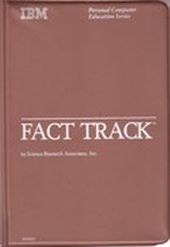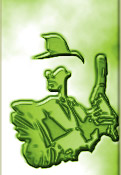
|
One of the pioneer programs for the new IBM PC platform, which was released among other educational games and applications as part of the Personal Computer Education Series collection. Despite the strange abstract title, it is devoted exclusively to mathematics and most likely corresponds to the level of the very first classes of elementary school. Given both the genre focused on textual presentation of the material and the year of release, graphic and musical delights are difficult - however, there is still some kind of CGA palette with animation, albeit on a black-and-black background, and sound accompaniment in the form of effects from PC Speaker. You can enable the latter after entering your name, - then we have to consistently make a choice of one of six sets of “facts”, several levels corresponding to it, and three different modes of the local game process. Under the options from the first category, simple mathematical operations are hidden, which our tasks can be devoted to: addition, subtraction, multiplication and division, as well as a combination of all of them (“Mixed”) and a complicated version of “Extensions”, in which three-digit numbers appear already ( albeit for the most part “round”). Each of these topics has its own level of complexity - “Level” (ranging from 1 to 4) or “Skill” (exclusively for “Extensions” - and already up to the seventh inclusive) - for example, at the easiest we will have problems like “2 + 2”, while at the highest - “28/7”, “121x10”, etc .; the first four operations among the levels also have the “All Facts” option, which will be discussed below. The last most important choice is the game mode: some explanations on the essence of the options presented here can be obtained by selecting the last item, “Fact Track explains ...”. In the first standard case, “Do 20 facts. How long? ”, We compete against the clock: how quickly will it be possible to solve the proposed twenty problems on the topic indicated earlier. In the third, “All I can do in X seconds”, the number of exercises is unlimited: you need to choose the desired duration of the lesson - from 20 to 200 seconds - and have time to complete as many tasks as possible before they expire. In both of these modes, you can also set yourself a “goal”: some desired result (from 50 to 99 seconds to solve those two dozen tasks - or a certain number of exercises ranging from 1 to 100, which we intend to overcome within a selected time period). The second of the three modes, “20 problems, X seconds each”, is slightly different from the others: here we are invited to solve twenty problems in the selected time (the number of seconds allocated to each exercise varies from 2 to 10), but not by entering an answer on a computer, and by hand fixing it on paper. It is difficult to say what is the point: in the end, we just see on the screen a list of correct answers, which, obviously, need to be compared with our recorded options. And therefore, two other ways to do mathematics seem more attractive: seeing the condition of the problem, we type in a solution that immediately evaluates to “Good” or “Wrong”; At the bottom of the screen are statistics of correct and incorrect answers, as well as the total number of exercises already completed. Pay attention only to the not the most obvious way of submitting tasks of the “Division” class: the divider is displayed first, and next to it, after a certain squiggle, is the dividend. In other words, “3┌0” should be understood as “0: 3 =?”. If before the start of the game you answered in the affirmative to the question about the desire to take part in the “race”, such will be clearly presented on the left side of the screen by the airplanes already described - if not, then the task’s animation will be reduced, as in the second of the three modes, to moving pieces of paper from the “Unused” stack on the left to the “Used” stack on the right. Upon completion, we will see our overall assessment - and a list of our mistakes, if any; in the latter case, it will be possible to replay these questions, as well as restart the entire lesson that has already been completed with the same conditions - or return to the main screen to a new selection of all indicators available here. Separately, it is worth mentioning that when you activate one of the first four topics - addition, subtraction, multiplication or division - and the “All Facts” difficulty level, only two modes are available to users, instead of three: in the first case, we will really be asked to solve all the problems here associated with the specified mathematical operation - without time limits, but with the possibility, if desired set yourself some goal; in the second, we will carry out exercises issued with a frequency of so many seconds, on paper and on our own. |








